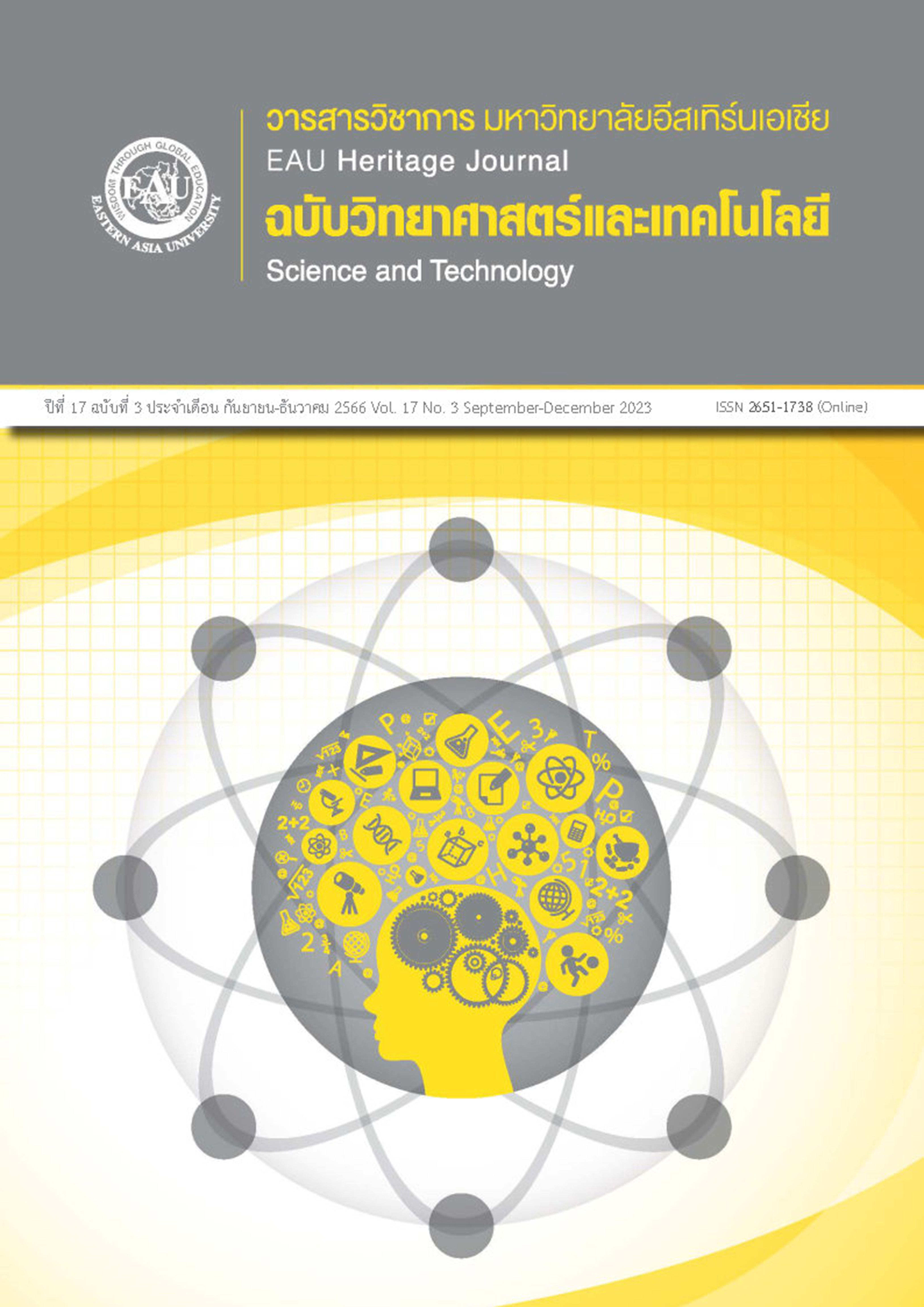การแยกเกลือออกจากน้ำทะเลด้วยระบบอัตโนมัติ
คำสำคัญ:
เทอร์โมอิเล็กทริค, อัลตราโซนิคฟอกเกอร์, การแลกเปลี่ยนความร้อน, ระบบการทำนาเกลือบทคัดย่อ
ปัจจุบันการนำน้ำทะเลมาแปรรูปซึ่งให้ได้ผลผลิตที่เป็นเกลือออกมานั้น ต้องใช้วิธีการต่าง ๆ หลายกระบวนการ ผู้วิจัยจึงได้นำเสนอวิธีในการลดต้นทุนการแยกน้ำและเกลือของน้ำทะเลออกจากกันโดยใช้เทคโนโลยีในปัจจุบันมาประยุกต์ใช้ งานวิจัยนี้ จึงมีวัตถุประสงค์เพื่อศึกษาแนวทางการออกแบบและสร้างระบบการแยกเกลือออกจากน้ำทะเลด้วยระบบควบคุมอัตโนมัติใช้หลักการทำงานของเทอร์โมอิเล็กทริคและอัลตราโซนิคฟอกเกอร์ ผู้วิจัยจึงได้ดำเนินการเก็บข้อมูลต่าง ๆ โดยมี 4 ขั้นตอนหลัก ขั้นตอนแรก คือ ประกอบโครงสร้างและอุปกรณ์ทั้งหมด ขั้นที่สอง คือ เริ่มการใช้โปรแกรมเพื่อเก็บข้อมูลจากเซนเซอร์และเปิดการใช้งานอุปกรณ์ทั้งหมด ขั้นตอนที่สาม คือ วิเคราะห์ข้อมูลและสร้างกราฟเพื่อเปรียบเทียบผลแต่ละการทดลองขั้นตอนที่สี่ คือคำนวณเปอร์เซนต์ประสิทธิภาพในการผลิตเกลือและสรุปผล ส่วนสำคัญคืออัลตราโซนิคฟอกเกอร์จะสร้างหมอกโดยการสั่นของคลื่นความถี่สูงบริเวณพื้นผิวน้ำจนทำให้น้ำกลายเป็นหมอกที่มีขนาดอนุภาคน้อยกว่า 5 ไมครอน ส่วนเทอร์โมอิเล็กทริคจะทำหน้าที่ในการสร้างเกลือโดยด้านร้อนทำหน้าที่ในการระเหยหมอกที่มีเกลือปนอยู่ให้กลายเป็นเกลือ ส่วนด้านเย็นจะทำหน้าที่ควบแน่นไอน้ำที่ได้จากด้านร้อนให้เป็นน้ำ จากการทดลองที่ความหนาชั้นน้ำ 3 ซม. 4 ซม. และ 5 ซม. ปริมาตรน้ำที่หายไปและอุณหภูมิฮีตซิงก์ด้านร้อนมีความใกล้เคียงกัน แต่มีขนาดอนุภาคของหมอกต่างกันมีผลต่อประสิทธิภาพในการผลิตเกลือ ซึ่งทำให้ความหนาชั้นน้ำ 5 ซม. มีความร้อนเกิดที่ฮีตซิงก์มากสุดเกิดประสิทธิภาพการระเหยเกลือได้สูงที่สุด
เอกสารอ้างอิง
Aberuee, M. J., Baniasadi, E., & Ziaei-Rad, M. (2017). Performance analysis of an integrated solar based thermo-electric and desalination system. Applied Thermal Engineering, 110, 399-411. doi: 10.1016/j.applthermaleng.2016.08.199.
Adafruit. (2017). MAX31865 PT100 and ARDUINO MEGA2560. Retrieved from https://forums.adafruit.com/viewtopic.php?t=127049.
Arduino. (2019). SPI library. Retrieved from https://www.arduino.cc/en/reference/SPI
Ahmadi, P., Khanmohammadi, S., Musharavati, F., & Afrand, M. (2020). Development, evaluation, and multi-objective optimization of a multi-effect desalination unit integrated with a gas turbine plant. Applied Thermal Engineering, 176, 115414. https://doi.org/10.1016/j.applthermaleng.2020.115414
Athasit, W., & Ukrit, T., (2023). Salt-water Phase-separation Method for Indoor Salt Farming Using Thermoelectric and Ultrasonic Atomization Technology. Thai Petty Patent No. 21754. Bangkok: Department of Intellectual Property
Cerci, Y. (2002). Exergy analysis of a reverse osmosis desalination plant in California. Desalination, 142(3), 257-266. https://doi.org/10.1016/S0011-9164(02)00207-2
Chen, D., Weavers, L. K., & Walker H.W. (2006). Ultrasonic control of ceramic membrane fouling: Effect of particle characteristics. Water Research, 40(4), 840–850. https://doi.org/10.1016/j.watres.2005.12.031
Demir, M. E., & Dincer, I. (2017). Development of an integrated hybrid solar thermal power system with thermoelectric generator for desalination and power production. Desalination, 404, 59-71. https://doi.org/10.1016/j.desal.2016.10.016
Doosti, M., Kargar, R., & Sayadi, M. (2012). Water treatment using ultrasonic assistance: A review. Proceedings of the International Academy of Ecology and Environmental Sciences, 2(2), 96. https://www.researchgate.net/publication/268393705_Water_treatment_using_ultrasonic_assistance_A_review
El-Dessouky, H. T., & Ettouney, H. M. (2002). Fundamentals of salt water desalination. Amsterdam, Netherlands: Elsevier.
Hosseingholiloua, B., Banakara, A., & Mostafaeib, M. (2019). Design and evaluation of a novel ultrasonic desalination system by response surface methodology. Desalination and Water Treatment, 164, 263–275. doi: 10.5004/dwt.2019.24458.
Khanmohammadi, S., Saadat-Targhi, M., Ahmed, F.W., & Afrand, M. (2020). Potential of thermoelectric waste heat recovery in a combined geothermal, fuel cell and organic Rankine flash cycle (thermodynamic and economic evaluation). International Journal of Hydrogen Energy, 45(11), 6934-6948. doi:10.1016/j.ijhydene.2019.12.113
Miller, E. W., Hendricks, T. J., & Peterson, R. B. (2009). Modeling energy recovery using thermoelectric conversion integrated with an organic rankine bottoming cycle. Journal of Electronic Materials, 38(7), 1206-1213. https://doi.org/10.1007/s11664-009-0743-1
Moossa, B., Trivedi, P., Saleem, H., & Javaid Zaidi, S. J. (2022). Desalination in the GCC countries-a review. Journal of Cleaner Product, 357, 131717. doi:10.1016/j.jclepro.2022.131717
Saadat-Targhi, M., & Khanmohammadi, S. (2019). Energy and exergy analysis and multi-criteria optimization of an integrated city gate station with organic Rankine flash cycle and thermoelectric generator. Applied Thermal Engineering, 149, 312-324. doi:10.1016/j.applthermaleng.2018.12.079
Seyed, M. P., Mohammad, H. A., Milad, S., Soroush, M., Fathollah, P., Lingen, C., Mohammad, A. Y., & Ravinder, K. (2019). Thermoelectric cooler and thermoelectric generator devices: A review of present and potential applications, modeling and materials. Energy, 186, 115849. doi: 10.1016/j.energy.2019.07.179
Shatat, M., Worall, M., & Riffat, S. (2013). Economic study for an affordable small scale solar water desalination system in remote and semiarid region. Renewable and Sustainable Energy Reviews, 25, 543–551. doi:10.1016/j.rser.2013.05.026
Tabletop Robotics. (2019). How to save Arduino Serial data to TXT file. Retrieved from https://www.youtube.com/watch?v=lz_AETY9o5E
Windsolargadget. (2016). Thermoelectric Cooler Peltier. Retrieved from https://www.windsolargadget.com/article/2/thermoelectric-cooler-peltie







